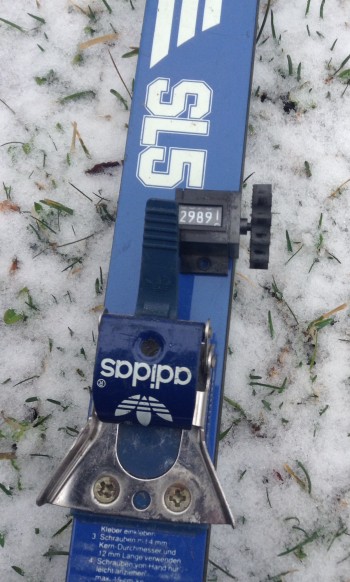A working committee of measurers from several snowy states – Duane Russell (Colorado), Scott Hubbard (Michigan), Jay Wight (Chicago), Jim Gilmer (upstate New York) and Justin Kuo (Massachusetts) – began studying the challenge of measuring in the snow and formulating possible ways to overcome it. Rick Recker of Minnesota was also tabbed as a group member, but was unable to get out of his apartment due to the eight-foot-high drifts that piled up and blocked his door for most of the winter.
After several abortive attempts at rigging the traditional bicycle for winter measurement, including snow tires and a front-mounted battery powered snow blower/melter fashioned from a pair of hairdryers, the committee decided to go in a completely different and non-traditional direction. The result was the Calibrated Cross Country Ski Method (CXCSM), which was able to be tested extensively thanks to the seemingly never ending winter.
The key apparatus in this new procedure is yet another iteration of the workhorse Jones Counter, this time known as the Jones Oerth Riegel Nordic Counter (JORNC). This device attaches directly to the measurer’s cross country ski, just ahead of the binding, and turns a fixed number of counts with each “schuss” of the ski.

“We tested it in Rocky Mountain powder, lake effect slush and a mix of hail, sleet and graupel from a Nor’easter, and the results were remarkably consistent,” said Russell, as he chipped away icicles in his moustache from a late-spring Denver snow squall. “I think this could really extend the effective measuring season, in some places, almost year-round.”
Praise for the new method was quickly forthcoming from the measurement community, with several members offering potential aids and improvements to the procedure. Bob Baumel was first to jump on the bandwagon, since cross country skis are measured in his beloved centimeters rather than inches. Mike Wickiser came up with a strobe light that could be attached to the ski tips for measuring on busy roads or in limited visibility, while Neville Wood announced he was working on a method to retrofit an electronic bicycle computer to a pair of ski goggles and connect it wirelessly to sensors mounted on the skis. And Mike Sandford offered to conduct a study of the variability of friction coefficients of different types of snow, although he admitted his results might take some time since the U.K. sees measurable white stuff about once in a decade.
Recker, currently in the federal witness protection program after receiving multiple death threats since his ill-advised decision to end the MetroDome indoor running program just prior to the worst winter in Twin Cities history, voiced his enthusiasm via a coded message delivered by carrier pigeon. “This could really be a boon to measurers in Minnesota and the northern states,” it read. “After this winter, I think we could be using it in Duluth to verify Grandma’s Marathon in June.”
Even Pete Reigel, former RRTC Chair and ex-officio curmudgeon, offered a grudging endorsement, stating, “If today’s measurers are crazy enough to go out and freeze their gonads measuring a 5K for some race in August, knock themselves out. Personally, I’m going to sit back in front of the fire with a nice Manhattan and watch the Ohio State basketball team make its run to the Final Four. Oh, crap.”
Not every reaction was quite so positive, it should be noted. RRTC Education Chair Toni Youngman of Florida first had to be convinced that skis aren’t always ridden in the water by someone being towed by a motorboat, and that snow is an actual element in many parts of the country, not just something sprayed on Space Mountain at Disneyworld.
And RRTC Chair Gene Newman, who spent most of his life in New Jersey, which plows the roads after snowstorms only at the whim of whatever politician has bribed his way into office that term, seemed reluctant to be reminded of the horrors of that winter existence. “I’ve been living in Arizona for just under a decade and I’m only now beginning to thaw out from some of those East Coast winters. I’d just about forgotten what a snow shovel was for and now you’ve got to bring those memories back? I’m going to have nightmares about blizzards for weeks now!” he said, slathering on more SPF 45 sunscreen before going out for a pre-dawn run while the Tucson temperature was still below 90.
The CXCSM will continue to undergo testing as long as there is snow on the ground, which in some parts of the country may be until Labor Day, and then will be brought to an up or down approval vote at December's USATF Annual Meeting in Anaheim. “It’s too bad we didn’t have this ready last year in Indy,” said Wight, noting that the snow that hit the city as the meeting began would have offered an excellent demonstration opportunity.

An alternate winter measuring procedure, the Calibrated Snowshoe Method, did not prove as successful and is unlikely to be brought up in Anaheim.
